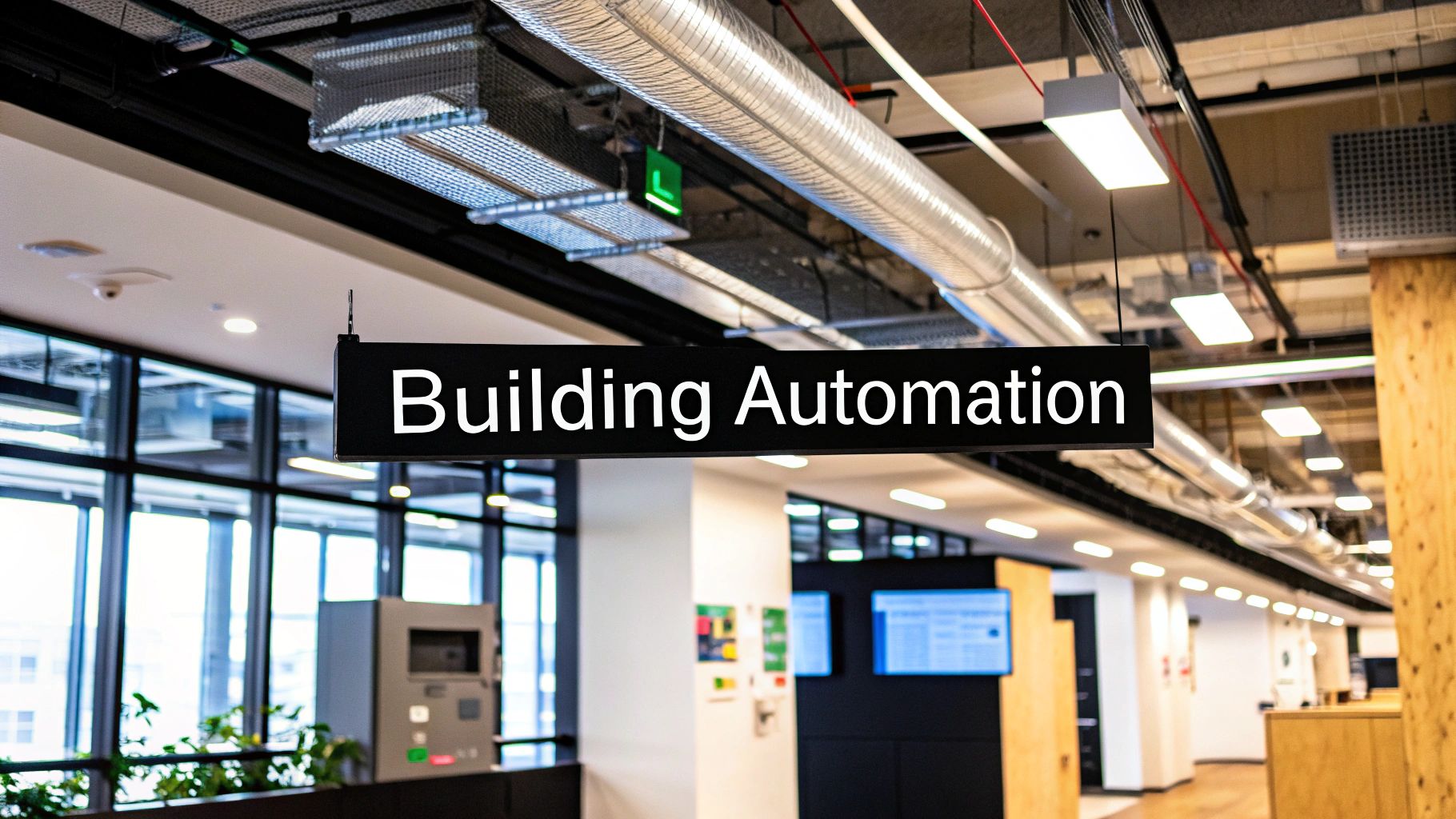Ever wondered what makes a modern building feel so… smart? The answer is often a Building Automation System (BAS). Think of it as the building's central nervous system, an intelligent network that senses what's happening and automatically adjusts to keep everything running smoothly.
It’s the invisible brain connecting and controlling all the essential systems—from heating and lighting to security and ventilation.
The Central Brain of Modern Buildings
A BAS acts as a single command center, swapping out old-school, separate manual controls for a cohesive, intelligent network. Picture a traditional building as an orchestra where every musician is playing their own tune. The HVAC runs on a fixed schedule, lights are either on or off, and the security system operates in its own little world. It’s functional, but it’s also chaotic and incredibly inefficient.
Now, imagine a conductor stepping in. That's the BAS. It listens to every "instrument"—every sensor and piece of equipment—and directs them to play in perfect harmony. The goal isn't just about flashy tech; it’s about making buildings genuinely better for the people inside them, far more efficient, and a whole lot cheaper to run.
Core Functions of a BAS
At its heart, a BAS handles a few critical jobs that turn a static building into a dynamic, responsive environment. These core functions are what make it so valuable.
Here’s a quick look at the four essential jobs a BAS performs to manage a building's environment and operations.
| Function | Description | Example |
|---|---|---|
| Monitoring | Continuously gathers data from sensors placed all over the building. | Tracking temperature, C02 levels, room occupancy, and ambient light. |
| Controlling | Sends commands to equipment based on the data it collects and pre-set rules. | Automatically dimming lights in an empty conference room or adjusting the thermostat. |
| Optimizing | Analyzes performance data over time to find ways to be more efficient. | Learning occupancy patterns to pre-cool a floor just before the workday starts. |
| Reporting | Gives facility managers detailed reports and real-time dashboards for visibility. | Creating an energy consumption report that pinpoints which systems use the most power. |
These functions work together to create a system that’s constantly learning and adapting, moving beyond simple on/off commands to truly intelligent operation.
The infographic below shows how a BAS sits at the top of the building's operational hierarchy, managing all the key functions from one place.
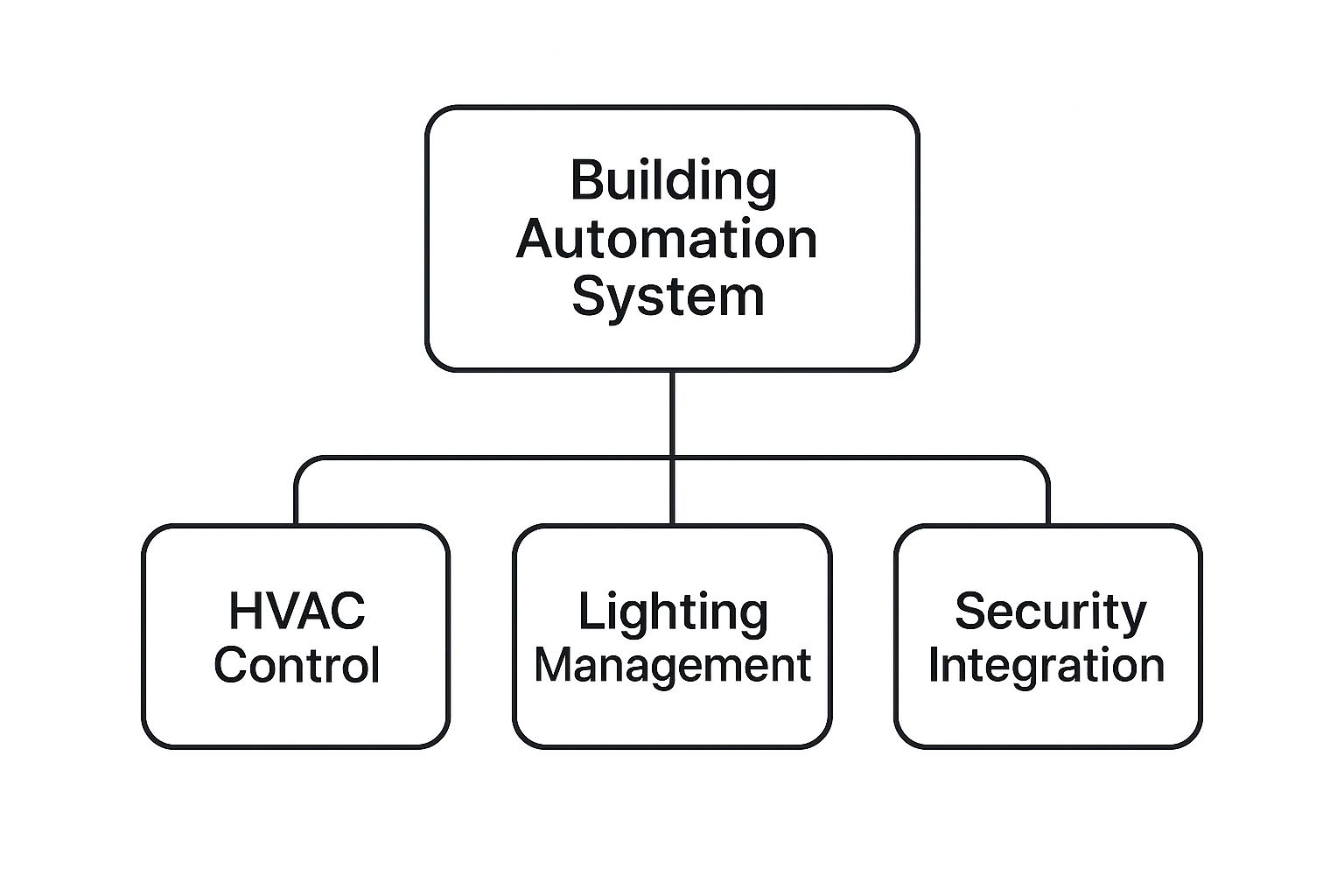
As you can see, a single BAS platform can orchestrate systems that used to be completely separate. By centralizing control, it breaks down operational silos and unlocks powerful new efficiencies. It's the key to turning raw building data into automated actions that benefit everyone, from the owner paying the bills to the people working inside every day.
How a Building Automation System Actually Works
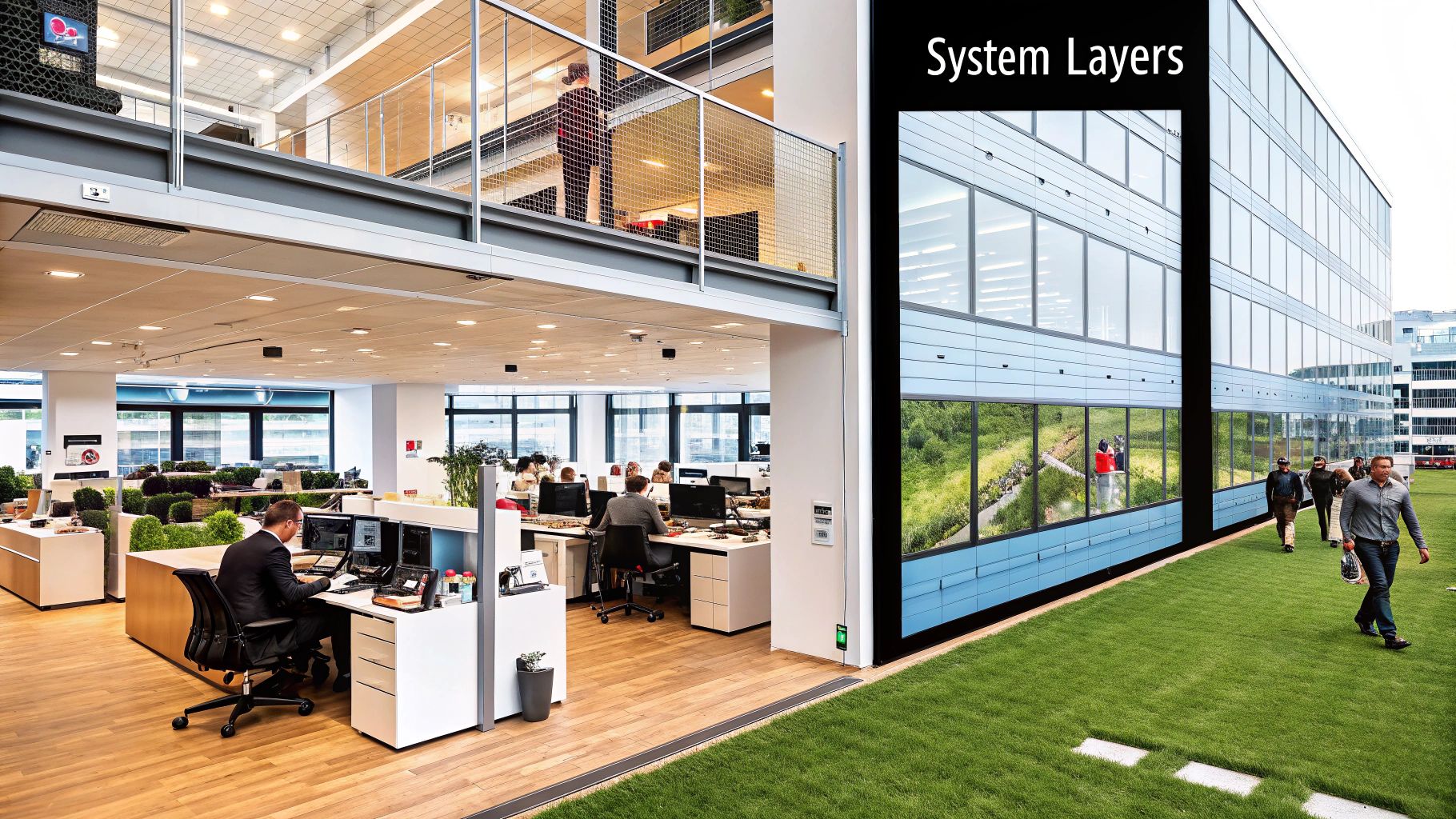
The best way to understand how a building automation system operates is to picture it as a three-layered pyramid. Each layer has a specific job, but they all communicate with each other constantly to create a seamlessly managed building. It's this structure that allows a BAS to sense, think, and act—turning a static collection of equipment into a smart, responsive ecosystem.
This tiered design ensures that information flows efficiently, from a tiny sensor in a first-floor office all the way up to the central dashboard in the facility manager's office. Let's break down how these layers work together, starting from the ground up.
The Field Level: The Senses and Muscles
The foundation of any BAS is the field level. Think of this as the building's nervous system—its eyes, ears, and hands, spread throughout the entire property. This layer has two main jobs: sensing what's going on and physically carrying out commands.
This is where the digital brain of the BAS meets the physical world of the building. Without it, the system would be completely disconnected and unable to make any changes.
The key components here are:
- Sensors: These are the eyes and ears. They gather raw data about everything happening in the building, like temperature sensors in rooms, occupancy sensors in conference halls, CO2 sensors monitoring air quality, and light sensors near windows.
- Actuators: These are the muscles. When the system decides something needs to change, actuators are the components that do the physical work. This could mean opening a valve on a heating pipe, adjusting a damper to redirect airflow, or dimming a bank of lights.
Simply put, sensors collect the "what is happening" data, and actuators execute the "make this happen" commands.
The Automation Level: The Local Managers
Moving up a level, we find the automation level, which acts like a team of local managers or supervisors. This layer is made up of controllers, most often Direct Digital Controllers (DDCs). These are the localized brains that process the information gathered by the field-level sensors.
Each controller is typically assigned to a specific area or piece of equipment, like the HVAC unit for the third floor or the lighting for the west wing. It takes in data from the sensors in its zone and uses its pre-programmed logic to decide what the actuators should do.
For example, a controller might get a signal from a temperature sensor that a room is too cold. It compares that reading to its programming (the desired temperature setpoint) and sends a command to an actuator to open a hot water valve, warming the room until the target is met.
This decentralized approach is incredibly robust. It means the entire building doesn't have a single point of failure. If one controller goes offline, it only affects its specific zone, leaving the rest of the building to operate normally.
The Management Level: The Central Command Center
At the very top of the pyramid is the management level. This is the central command center—the bridge between the system's technology and the human operator. It’s typically a software application running on a server, with a user-friendly dashboard that can be accessed from a computer or even a tablet.
From here, a facility manager can:
- Visualize Data: Get a real-time, bird's-eye view of the entire building's operations on a single screen.
- Adjust Setpoints: Tweak temperature schedules, lighting scenes, and other parameters for the whole building or just specific zones.
- Analyze Trends: Dig into historical data to spot patterns in energy use and see how equipment is performing over time.
- Receive Alarms: Get instant notifications if a piece of equipment fails or if conditions fall outside of acceptable ranges.
This is where the big-picture decisions are made. A BAS's core function is to precisely control and monitor a building's crucial services, including its vital Mechanical, Electrical, and Plumbing (MEP) systems. The management level provides the holistic view needed to juggle all these integrated components effectively.
Getting these layers to communicate correctly is a detailed journey, and understanding the complete building automation system installation process is key to a successful project. By working in harmony, these three levels create a system that not only automates tasks but also optimizes performance for maximum efficiency and comfort.
The Core Components of a Modern BAS
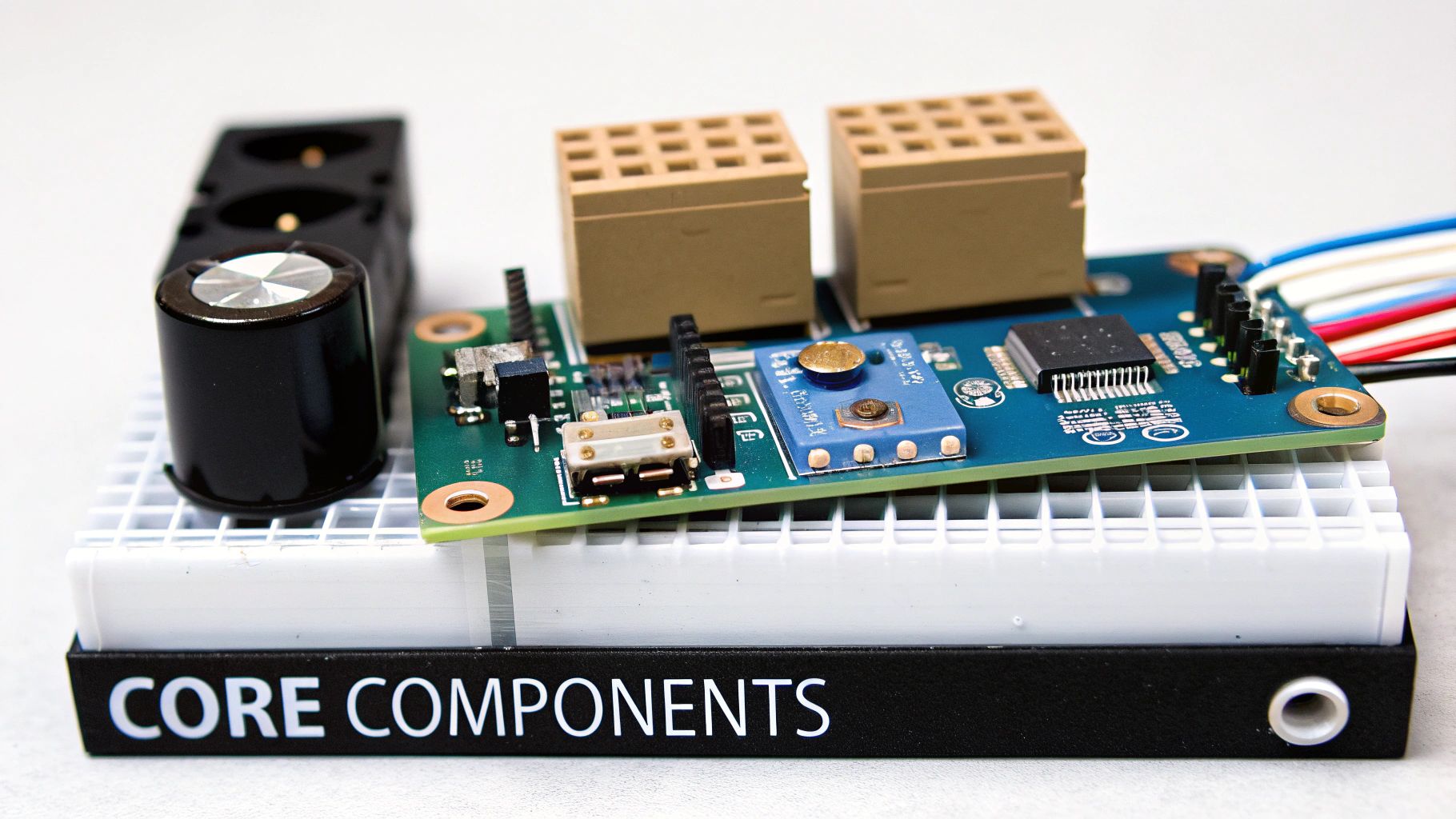
To really get what a building automation system does, you have to look under the hood. It’s not one single piece of technology but a whole team of specialized components working in concert.
Think of it like a human body. The system has sensory organs, a decision-making brain, and physical limbs that take action. By understanding how this ecosystem works, you can see how a simple bit of information—like an empty room—triggers a real-world, energy-saving response.
Let's break down the three fundamental parts that make it all happen.
Sensors: The Eyes and Ears of the Building
Everything starts with data. Sensors are the tireless data collectors scattered throughout a facility, acting as the building's nerve endings. They’re constantly gathering real-time information about what’s happening in and around the property.
Without good data from its sensors, a BAS is flying blind. It can’t make smart decisions.
These devices come in all shapes and sizes, each built to measure a specific condition:
- Occupancy Sensors: Using infrared or ultrasonic tech, these detect when people are in a room. This is key to making sure lights and HVAC aren't running in empty spaces.
- Temperature Sensors: You'll find these in rooms, air ducts, and on equipment. They provide the essential data for precise climate control.
- CO2 and Air Quality Sensors: These sniff the air for carbon dioxide and other pollutants, telling the ventilation system when it's time to bring in fresh air.
- Light Sensors (Photocells): Placed near windows, these measure natural daylight. The BAS uses this info to automatically dim indoor lights, a practice called daylight harvesting.
Every single automated action a BAS takes starts right here, with a sensor.
Controllers: The Decision-Making Brain
After a sensor collects a piece of data, it sends that information to a controller. Controllers are the local brains of the operation. They process the incoming data and decide what to do based on pre-programmed rules and setpoints.
If sensors are the eyes and ears, controllers are the part of the brain that figures out what the signals mean and what to do next.
For example, a sensor might report that a meeting room is 74°F. The controller gets this info, checks it against the programmed setpoint of 72°F, and knows it needs to cool the room down. These smart devices are the critical link between sensing a change and making something happen.
A huge plus of having multiple controllers is decentralization. If the controller for the lighting system goes down, the HVAC controller keeps chugging along. The building's most important functions stay online.
Actuators: The Hands and Muscles
Once a controller makes a decision, it issues a command to an actuator. Actuators are the "muscles" of the BAS. They are the physical devices that actually carry out the commands and interact with the building's equipment.
Let's finish our example. The controller decided the room was too warm, so it sends a signal to an actuator. That actuator could be:
- A motor on an air damper that opens to let more cool air into the room.
- A device on a valve that adjusts the flow of chilled water.
- A mechanism on a window blind that lowers it to block the sun's heat.
This three-step "sense, decide, act" loop happens thousands of times a day throughout a building, all without anyone lifting a finger. This incredible integration is why the global Building Automation Systems market is valued at over USD 202.29 billion. Fueled by new construction and smart city projects, the market is poised for major growth—you can explore detailed market growth projections on Mordor Intelligence.
This kind of connectivity is also a core concept in the Internet of Things for building automation, where more and more devices are being linked together to create even smarter, more responsive environments.
Unlocking the Benefits of Building Automation
Knowing how a building automation system works is one thing. But the real question is, why should you care? The answer is simple: a BAS transforms a building from a reactive, costly asset into a proactive, intelligent, and highly efficient environment.
It’s about more than just fancy tech. This is a strategic investment that delivers tangible returns across the board, from slashing utility bills to creating healthier, more productive spaces for the people inside.
Drastic Energy Savings
The first and most obvious win from a BAS is a major cut in energy use. Think about a typical building. How often is the air conditioning blasting in an empty conference room or are lights left on all night? This kind of waste is commonplace, but a BAS puts a stop to it.
Using a network of sensors, a BAS makes sure energy is only used when and where it's actually needed. No more guesswork, no more waste.
- Smart Scheduling: The system is smart enough to know when the last person leaves a room. It then automatically turns off the lights and dials back the thermostat to an energy-saving mode.
- Daylight Harvesting: On a sunny day, why pay for full-power lighting? A BAS can dim interior lights based on the amount of natural sunlight available, keeping rooms perfectly lit while cutting electricity costs.
- Peak Demand Management: The system can also help avoid those punishing "peak demand" charges from utility companies by intelligently shedding non-essential electrical loads during high-cost periods.
These automated adjustments aren't trivial. They can lead to energy savings of 15% to 30% or even more, which goes straight to your bottom line.
Reduced Operational Costs
Beyond the utility bill, a BAS makes the entire operation more affordable by revolutionizing maintenance. The old way was to wait for something to break—an air handler fails on the hottest day of the year, leading to expensive emergency repairs and unhappy occupants.
A BAS flips the script to predictive maintenance.
It's like having a 24/7 health monitor for your building's most critical equipment. The system constantly tracks performance, flagging tiny issues—an unusual vibration, a dip in efficiency—long before they escalate into catastrophic failures.
This foresight allows facility managers to schedule repairs on their own terms, not in a panic. This proactive approach extends the lifespan of expensive equipment, minimizes disruptive downtime, and slashes overall maintenance spending. It's no wonder the global Building Automation System market was valued at USD 92.20 billion and is expected to nearly double by 2030. You can discover more insights about BAS market trends on MarketsandMarkets.
Enhanced Occupant Comfort and Productivity
Let's be honest: a comfortable person is a productive person. A BAS is the key to creating an indoor environment where people can thrive. It fine-tunes temperature, humidity, and air quality in real-time, eliminating those constant complaints about one office being an icebox while another is a sauna.
The system can even monitor CO2 levels, automatically bringing in fresh air to prevent that stuffy, drowsy feeling that kills focus. This meticulous environmental control doesn't just make people happier; it's been proven to boost cognitive function and overall well-being. This kind of intelligent control is reshaping the industry, and as you can learn in our guide to IoT in property management, it's a core piece of modern facility strategy.
The difference between the old way of managing a building and the new, smarter approach is stark. This table breaks it down.
Traditional Building vs. Smart Building with BAS
| Feature | Traditional Building | Smart Building with BAS |
|---|---|---|
| HVAC Operation | Runs on a fixed schedule, regardless of occupancy. | Adjusts based on real-time room usage and weather. |
| Maintenance | Reactive; repairs are made after equipment breaks. | Predictive; issues are flagged before they cause failure. |
| Lighting Control | Manual on/off switches; often left on in empty rooms. | Automated dimming and shut-off based on occupancy. |
| Data & Insights | Minimal data; relies on manual checks and guesswork. | Centralized dashboard with real-time analytics and reports. |
| Operating Costs | High and unpredictable due to energy waste and repairs. | Lower and more predictable through efficiency and foresight. |
Ultimately, a BAS isn't just about automation; it's about intelligence. It provides the data and control needed to run a building that is not only cheaper to operate but also a better place to be.
Exploring Real-World BAS Applications
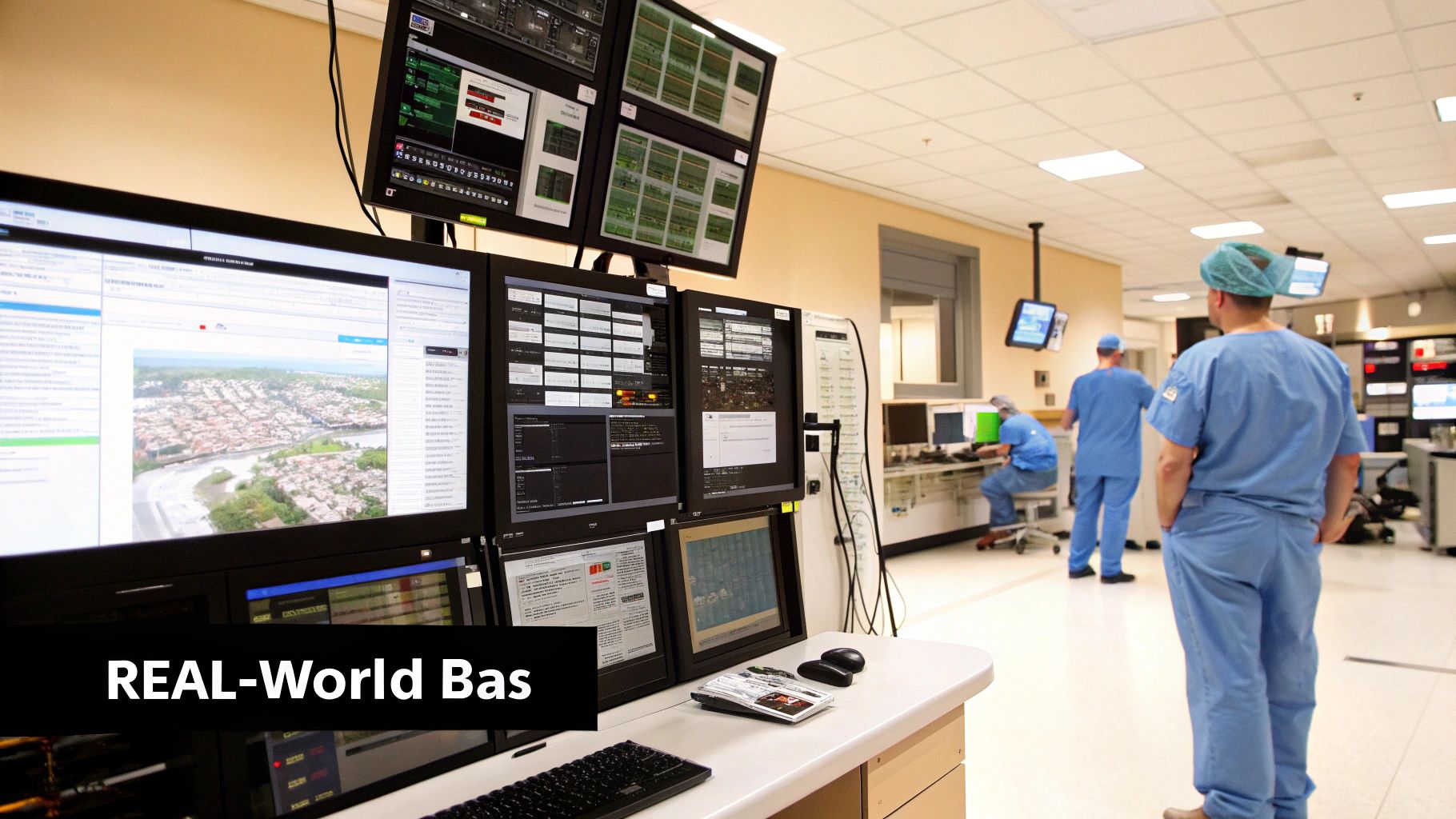
The theory behind a building automation system is one thing, but seeing it in action is where its true value really clicks. This technology isn't just about collecting data or running algorithms; it’s about solving very real problems and making the spaces we use every day better.
A BAS is often the invisible engine keeping our most important buildings efficient, comfortable, and safe. Let’s look at a few examples that show just how adaptable these systems are when faced with unique and demanding challenges.
Precision and Safety in Healthcare Facilities
Hospitals are one of the best places to see a BAS in its element. In a healthcare setting, precise environmental control isn't a luxury—it's a matter of life and death. A BAS is critical for maintaining the sterile and stable conditions that patient care depends on.
Think about an operating room. The BAS is working tirelessly to control air pressure, creating a positive-pressure environment that actively pushes contaminants out and prevents airborne pathogens from getting in. At the same time, it holds temperature and humidity within incredibly tight tolerances, which is vital for patient outcomes and the function of sensitive surgical equipment.
But the system is also smart enough to know that not all areas have the same needs.
- Clinical Wings: In labs and patient rooms, the BAS prioritizes air quality and consistent temperatures to meet strict regulatory standards.
- Administrative Areas: In offices and lobbies, the system can switch its focus to energy efficiency, dialing back HVAC and lighting based on occupancy to cut costs without affecting the facility's core medical mission.
This ability to dynamically manage different zones allows hospitals to uphold the highest safety standards while reining in the massive energy consumption these facilities are known for.
Efficiency and Scale in University Campuses
A large university campus is practically a city unto itself. You have dozens of buildings, thousands of rooms, and constantly changing schedules. Trying to manage that environment manually would be a logistical nightmare.
This is where a BAS provides a centralized command center. A small facilities team can oversee the entire campus from a single interface, controlling everything from the ventilation in a lecture hall to the lighting in the library.
For example, a BAS can sync directly with the university's class scheduling software. An hour before a class starts, it automatically warms or cools the room to a comfortable temperature. Fifteen minutes after everyone has left, it dials everything back to an energy-saving "unoccupied" mode.
When you apply that simple, automated logic across an entire campus, the results are staggering. We're talking millions of dollars in utility savings each year and a major reduction in the university's carbon footprint.
Uptime and Protection in Data Centers
In the world of data centers, downtime simply isn't an option. These facilities house the servers that run our digital world, and those servers generate a tremendous amount of heat. If things get too hot, you're looking at catastrophic equipment failure and data loss.
A BAS serves as the first and most important line of defense against overheating. It provides constant, real-time monitoring of temperature and humidity at the server rack level. If it detects a hot spot forming, the BAS can react instantly.
- It can ramp up specific Computer Room Air Conditioning (CRAC) units to direct more cool air to the problem area.
- It can adjust chilled water flow to boost cooling capacity exactly where it's needed.
- It sends an immediate alert to the operations team long before the issue becomes critical.
This kind of proactive cooling management is what makes the 99.999% uptime that data centers promise even possible. Here, the BAS isn't just keeping a building comfortable; it's protecting billions of dollars worth of digital infrastructure.
The Future of Building Automation
Building automation isn't standing still—far from it. The next generation of smart buildings is already taking shape, powered by the Internet of Things (IoT) and Artificial Intelligence (AI). These technologies are pushing buildings beyond simple automation and into a new era of being truly autonomous and self-improving.
If you think of a traditional BAS as a system that just follows a pre-written script, then IoT gives that system thousands of new eyes and ears. Small, inexpensive wireless sensors can be placed almost anywhere, gathering incredibly granular data on everything from whether a desk is occupied to the faint vibrations of a machine that's about to need a repair.
The Rise of AI and Machine Learning
This flood of new data is exactly where Artificial Intelligence (AI) and machine learning (ML) come into play. AI acts as the building's brain, capable of sifting through all that information and finding patterns that a human never could. It turns raw data into genuine foresight.
Instead of just reacting to what's happening right now, an AI-powered building can anticipate what's coming next. This is the real difference between simple automation and true autonomy.
An AI-driven system can do things like:
- Learn Occupant Patterns: It can figure out that a specific department always starts arriving at 8:30 AM and begin cooling their office space just before, instead of running the AC all night.
- Predict Maintenance Needs: By analyzing performance data, it can flag a motor that’s showing early signs of wear and tear, predicting it will fail next month. This turns a costly emergency shutdown into a simple, scheduled repair.
- Anticipate External Factors: The system can pull tomorrow's weather forecast, see a heatwave is coming, and decide to pre-cool the entire building overnight when electricity is cheapest.
We’re already seeing real-world examples of how AI is transforming HVAC systems, moving beyond basic controls into a more predictive and intelligent space.
This isn't science fiction. It's the practical application of data science to create environments that are not just smart, but prescient. Buildings are transitioning from following commands to making their own intelligent decisions.
A Market Poised for Growth
This shift in technology is driving massive growth in the industry. Market projections show a clear upward trend, with some estimates suggesting the building automation sector could be worth as much as USD 633.5 billion by 2035.
This growth is happening as more companies adopt platforms that integrate HVAC, lighting, security, and energy analytics into one seamless network. Some are even using machine learning to operate buildings almost entirely on their own, giving us a real glimpse into the future of building management.
Common Questions About Building Automation
As you start to wrap your head around building automation, a few practical questions always pop up. It's one thing to understand the concept, but another to figure out what it actually means for your budget, your building, and your team. Let's tackle some of the most common ones head-on.
How Much Does a Building Automation System Cost?
There’s no simple price tag. The cost of a BAS really depends on the size of your building, how complex you want the system to be, and how many different pieces of equipment you're connecting. A basic system for a small office could be in the tens of thousands, while a full-blown BAS for a sprawling hospital or university campus can easily climb into the millions.
But the real story isn't the upfront cost—it's the return on investment (ROI). The energy and operational savings are so significant that a BAS often pays for itself within 3-7 years. Think of it less as an expense and more as a long-term financial strategy.
Can a BAS Be Installed in an Older Building?
Yes, and it’s a huge part of the industry. Retrofitting older buildings with modern automation is not only possible but incredibly common. Thanks to modern wireless sensors and controllers, installations are far less disruptive than they used to be. You can often skip the headache and cost of pulling new wires through old walls.
In fact, older, less-efficient buildings often get the biggest bang for their buck. They see the most dramatic drops in energy use and the biggest leaps in occupant comfort after a BAS retrofit. It's one of the best ways to bring a legacy property into the 21st century.
What Is the Difference Between a BAS and a BMS?
You'll hear Building Automation System (BAS) and Building Management System (BMS) thrown around a lot, and for good reason—they're now used almost interchangeably.
If you want to get technical about their history, "BAS" sometimes referred more to the actual hardware—the controllers and sensors doing the work—while "BMS" was the software dashboard the facility manager looked at.
Today, any modern system is the whole package. The BAS is the entire nervous system of the building. The BMS is the screen you use to see what it's thinking and tell it what to do. They’re two sides of the same coin.
At Clouddle Inc, we specialize in designing and installing the integrated technology solutions that power modern smart buildings. From networking and security to complete automation, we deliver the end-to-end infrastructure that makes your property more efficient, secure, and intelligent. Discover our managed technology solutions and see how we can help you build for the future.


